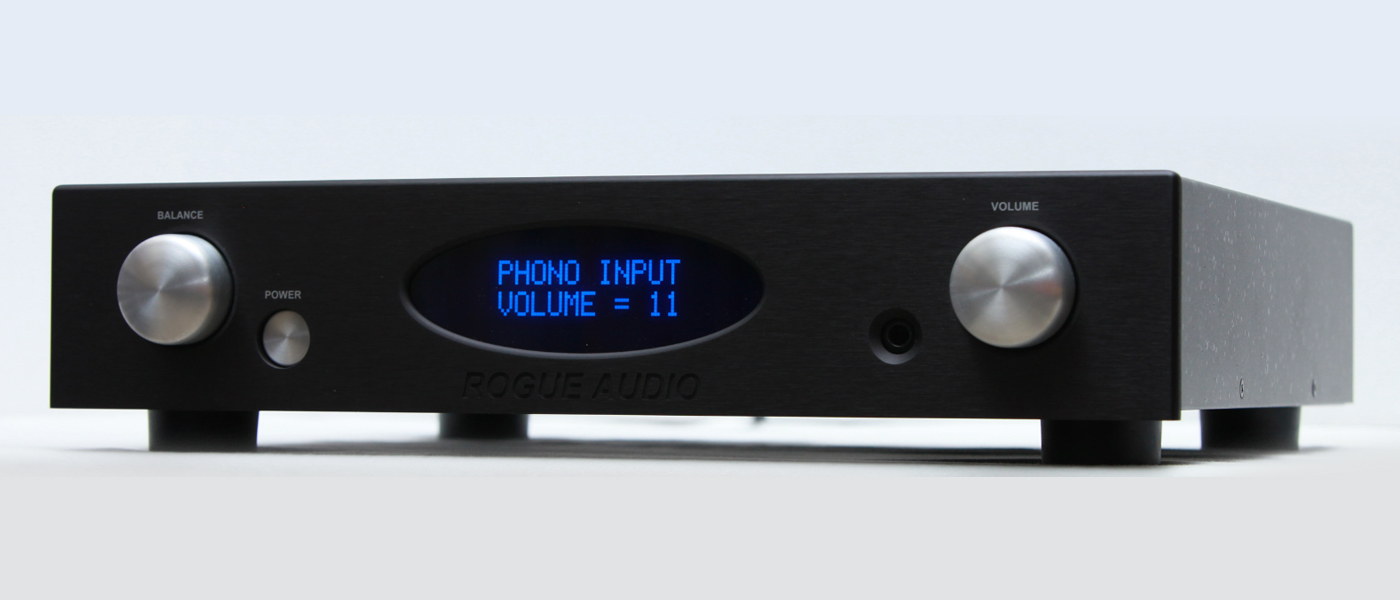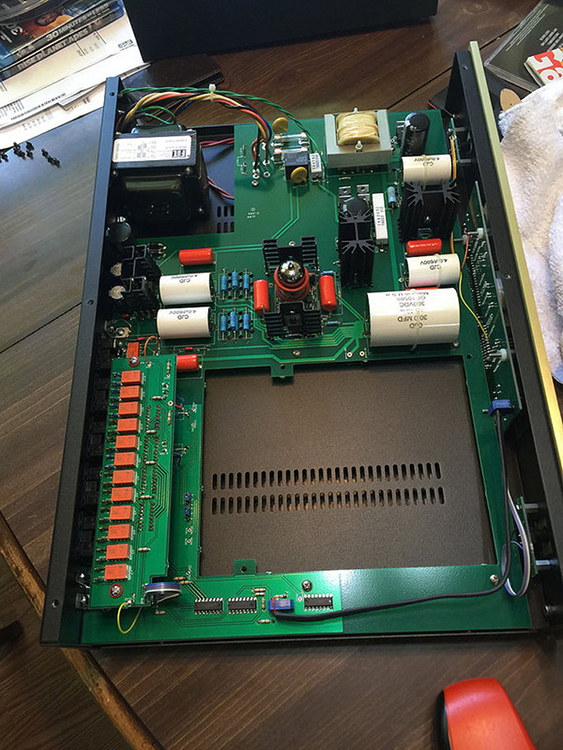However since it retails for $4000 without a phono stage ($5500 with), and the base ET3 line stage goes for only $2950 on Amazon with free shipping, I thought a review of the 25%-off base version might be appropriate.
Conrad-Johnson has a storied reputation for building some of the finest-sounding preamplifiers in the world. Their philosophy of “use the absolute minimum number of the highest-quality parts” is on display in the ET3.
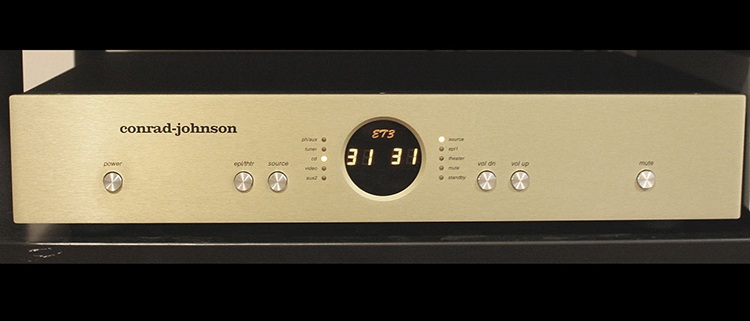
Conrad-Johnson ET3 Tube Stereo Preamplifier
- Significant savings over the SE version of the same preamp
- A very accomplished rock-n-roll preamp
- Teflon capacitors & high quality resistors
- Classic champagne-gold faceplate
- Home theater bypass
A pair of PhD economists who are also world-class practitioners of audio design run the conrad-johnson company. The lower case leading letters are intentional. Since the 1970’s, Drs. William Conrad and Lewis Johnson have designed and produced a series of audio electronics (mostly preamplifiers and power amplifiers) that have consistently received the highest audio reviewer rankings.
Gain:
25dB
Maximum Output:
20Vrms
Distortion:
Less Than .15% THD
Impedance:
100Ohms
Freq. Response:
2Hz – >100KHz
Hum and Noise:
98dB below 2.5V
Phase:
Phase Inverting
Tube Compliment:
1 x 6922
Company:
SECRETS Tags:
Conrad Johnson, Preamp, Preamplifier, Tube, Vacuum Tube, Line Stage, CJ, Unbalanced
The conrad-johnson design company is located in Fairfax, Virginia. After decades in business, the company is still sound, still innovative and still produces a uniformly high-quality line of products.
Unlike most brands, don’t expect to buy a conrad-johnson (CJ) product and then have a newer version suddenly make your purchase obsolete. Most CJ products tend to remain in production for years. This longevity is not an indication of sloth on the part of the designers, but is, rather, due to the fact that until better technology is available, CJ doesn’t believe in constantly upgrading or tweaking their gear.
CJ has a design philosophy of “less is more.” They’ve been quoted as saying that a design is finished when no more parts can be removed. By minimizing the parts-count, more of the design budget is available to optimize the quality of the remaining components.
This philosophy is evident in the ET3 line stage preamplifier. The large white cylinders in the photo are Teflon capacitors. They are some of the most expensive available, but CJ considers them justified for their dielectric properties and their sound. Also in use are low-noise, metal-film resistors. The parts quality is evident in the low noise floor of the ET3 and in its lively audio presentation.
Secrets Sponsor
The ET3 is also fitted with a resistor-ladder, relay-switched volume control. Such a control costs significantly more than the variable-resistance wiper controls found on most preamplifiers (even the most expensive ones), but results in more consistent channel-to-channel balance throughout the entire volume range.
Attention to detail is also present in the smaller things. The gold-plated input and output jacks are of very high quality, and the vacuum tube (a single, dual-triode 6922) is fitted with a pair of flexible ring-dampeners to suppress tube microphonics.

The factory tube is a Russian-made Electro-Harmonics, and since there is but one, inexpensive tube-rolling is possible. Normally when two tubes are present, one must purchase matched pairs in order to maintain channel-to-channel balance. The added cost prices many owners out of the tweaking experience. With the ET3 a single tube is sufficient, and the expense of buying gain-matched pairs is unnecessary. It is also far more probable that the two internal plates of a single tube are going to be exactly matched and will age at the same rate.
Secrets Sponsor
Even the front panel is finely finished with beveled buttons and a clean look.
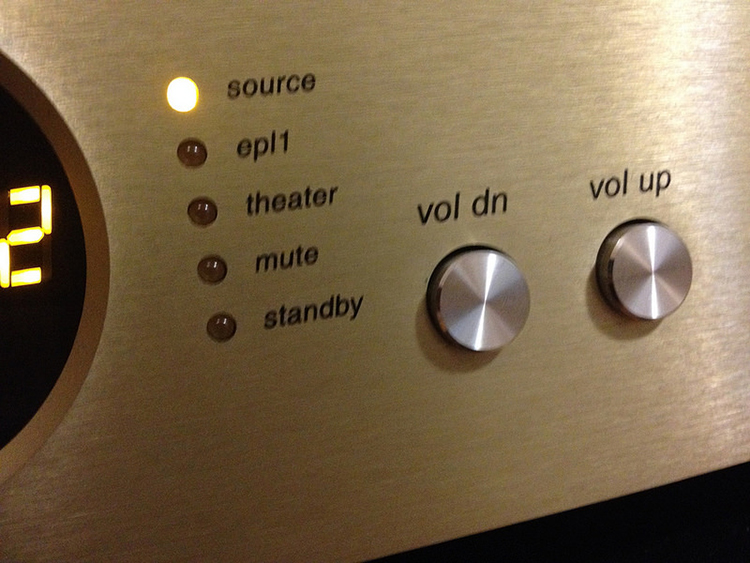
The ET3 was used to replace a McIntosh C220 tube preamp, which replaced an Emotiva (solid-state) XSP-1 Gen 2 preamp. My associated equipment included:
- JRiver Media Center 21 for Mac playing WAV files from a USB-RAID-HDD
- Oppo BDP-105 (used as disc player & DLNA-connected DAC)
- Emotiva XPA-2 Gen 2 solid-state power amplifier
- Axiom M-100 loudspeakers
- PowerSound Audio XV-15se subwoofers (2)
The RCA interconnect cables were somewhat difficult to plug into the ET3 due to the high force required for inserting them into their sockets. I ended up having to hold the front of the (light weight) preamplifier with one hand while pressing the plugs into the back. I have no complaint about this, but do note it in passing.

I’d also comment here about CJ’s attitude toward balanced circuitry. Although they concede that XLR cables and balanced circuitry have their place in commercial audio, they contend that for home audio, balanced circuitry is “a solution in search of a problem.” This is fully in keeping with the CJ proclivity for simple circuitry.
CJ’s emphasis on simplicity can cause some issues, though. I drive my main speakers full-range and use the low-pass crossovers on the subwoofers’ plate amplifiers to blend in the bass. Since the CJ has but a single pair of volume-controlled preamp-out jacks, I have to use a splitter cable to drive both the power amp and the subs. A second pair of main output jacks would have been nice.
The ET3 includes a black plastic, non-backlit remote control with input selection, volume control and mute buttons. It performs adequately.
First, note that the ET3 is phase inverting. This is critical when using subwoofers. I prefer to run my speakers full-range and then use the low-pass crossover on the subwoofers’ plate amplifiers to blend the bass. I initially thought that the ET3 had a weak bass response. Then I remembered to set my subs’ phase to 180 degrees instead of the more common zero degrees. Reversing the speaker wires (at the speakers only) red to black terminal and vice versa while leaving the subs at zero-phase would have also been effective. Once the phase was consistent, the reviewing began.
One of my audio friends who visited me for an audition, Mr. Garuka de Silva, instantly proclaimed, “This is the greatest rock and roll preamp EVER.” I tend to agree.
The CJ has a unique sound that isn’t much like anything else I’ve heard, except maybe from the Wadia brand of DACs. It’s very interesting how different my Axiom speakers can sound when the CJ is in the system. The sound wasn’t like that of the McIntosh C220 tube preamp, nor did it sound like my former Emotiva XSP-1. The ET3 had its own unique presentation.
If you like Pink Floyd, Van Halen, Kool-Moe-Dee, or anything else with deliciously funky electric guitars, this is the preamp for you. A capsule description of the sound would be “lit up from the inside.” Mr. de Silva felt that the CJ had a similar sound to that of class-A, solid-state power amplifiers, but with a lot more tube magic going on, of course. In short, this is a preamp you can crank.
The CJ did a bit better than both the Mac and the XSP-1 with lower bass that provided more impact, more slam and more room pressurization. The Mac and the Emotiva preamp have more neutral bass sounds. The McIntosh in particular has a nice laid-back air with a very natural in-room feel. The CJ said, “Laid-back? I’ve never heard that term!” and proceeded to give you so much rocking goodness it made your head spin. I don’t think my toes ever stopped tapping; I was drumming out tunes in the air!
The “lit from within” perspective could be varied to some extent with different brands of tubes. A variety were tried including the factory Electro-Harmonix, a Genelex Gold Lion premium and a Telefunken. The Genelex tube was the liveliest with the Electro-Harmonix in the middle and the Telefunken the most laid-back. But even with the latter installed the sound was still livelier than either of the other two preamplifiers.
Playing rock music, it’s hard to describe how intoxicating the ET3 is. If the preamp could speak for itself it might say, “Bring back the ’70s and all its delicious grooving, but with exceptional resolution and high fidelity.” Make no mistake – this preamp can rock! It really enhances pop music. I can’t think of another preamplifier that I’ve auditioned that jams like this.
The McIntosh is more about intimate jazz, a smoky bar room, Holly Cole caressing your ears, and an organic, natural presentation. The Emotiva XSP-1 is Sergeant Joe Friday (“just the facts, ma’am”). But in the CJ’s case, somebody turned on the nicest tube guitar amp you’ve heard and voilà! – The Grateful Dead perform right in front of you. Neither of the other preamplifiers had this degree of presence.
Drums sounded quite good as well. You can easily discern all the different and delicate things the drummer is doing. Also the midrange whack of the drumheads, particularly on the toms, comes through with lots of power. The temptation is to keep turning the volume up because it sounds so good – so much that the clipping level of the power amplifier is easily approached.

Cymbals shimmered spectacularly. And this is one of the biggest pluses & minuses of the CJ preamp. Cueing up Norah Jones (a favorite reference album), we began with the song, Come Away With Me. Did you know what there is a cymbal being brushed almost continuously throughout that entire song? Listening to the same track on either the McIntosh C220 preamp or the XSP-1 the cymbal is clearly audible.
But I never noticed it before until the ET3 called attention to it. And there is a lot of detail in that cymbal shimmer. Mr. de Silva asked to stop this song that we’ve both listened to many, many times and said…”wait – did you hear that cymbal?”
From the same album, we listened to the track, Lonestar. During this song there is an acoustic slide guitar performed by Mr. Adam Levy. As he plays the notes, he shakes the slide to add a secondary percussive sound on top. It’s very subtle and not every piece of gear can bring it to life but the CJ was up to the task!
That being said, the treble emphasis that is so pleasant on some music can be a bit too much in other cases. Orchestral cymbals sometimes take on a life of their own and stand out too much. When I attend a symphony concert, I’m accustomed to certain percussive treble sounds that float over the orchestra; typically cymbals and triangles. But the CJ overemphasizes this frequency range. If your system is also bright, this alone may be a deal breaker.
In the midrange, horns sound like the contrast is turned slightly up (mostly in a good way) and jump out at you, demanding your attention. The downside of this is that Norah Jones’ voice became less natural. When the vocal comes in, the contrast is too great. It sounds like she’s coming out of the soundstage to sing directly into your ear, and with a bright, harsh edge. But there were several other songs where the effect was quite pleasant.
We often buy a high-resolution stereo system and suddenly find that all the songs we really liked on the radio no longer sound so good. Instead, we start listening to well-recorded fare that nobody would otherwise listen to because it’s the stuff that sounds good on the system. Eventually, Led Zeppelin, Reverend Horton Heat and Dash Rip Rock fall off the playlist for good. And I miss that – I miss the fun tunes.
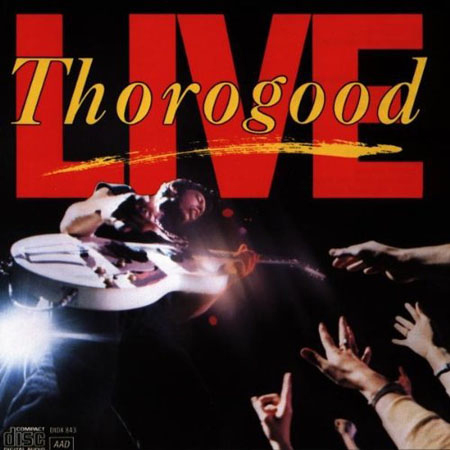
The good news is that the CJ makes even less-than-audiophile recordings fun again! For a classic example, George Thorogood’s live performance of One Bourbon, One Scotch & One Beer comes alive in your room through the CJ. Mr. de Silva went home, fired up his (solid state) stereo, and played the same tune at about a third of the volume we’d just listened at through the CJ. After about 15 seconds, his significant other said, “I don’t want to hear this.”
And you know what? He didn’t either! It just wasn’t enjoyable on his system. You couldn’t crank it much. But on the CJ, we listened to the entire song cranked up to near clipping, and it sounded so good; that’s what this preamp can do.
Using the ET3 with a more laid-back vacuum-tube power amplifier would probably balance out the treble better. Unfortunately I didn’t have one on hand to audition. But I’d say that if you have a neutral solid-state power amplifier and neutral speakers, the treble emphasis and the midrange dynamics of the ET3 might not be your cup of tea. Even worse, if you have older solid-state amplification, that tends to be brighter in the treble, or if you have a pair of speakers that also emphasize the treble region, then the ET3 is definitely not for you.
But it’s also fair to say that the Telefunken tube did away with about 50% of the treble emphasis while also opening the sound stage significantly and maintaining the ET3’s signature sound.

After about 100 hours of burn-in time, I tried the ET3/Telefunken combination with one of my favorite recordings of piano & orchestra, Grieg’s Piano Concerto performed by Jeno Jando and the Budapest Symphony Orchestra. The bottom registers of the piano were richly harmonic and very present but the midrange and higher notes on the piano occasionally seemed splashier than I’ve heard with other equipment. I’m thinking that (again) the treble emphasis of the ET3 is to blame.
Since I lack acoustic or electrical test equipment, I can’t verify the ET3’s frequency range against CJ’s specs. I do note however that CJ specifically doesn’t specify a frequency response variance (plus or minus how many decibels) over the preamp’s total frequency range. Even if the frequency response does measure ruler flat, the perceived treble emphasis is a consistent artifact of the preamplifier’s sound.
At the time of this audition, I had two power amplifiers available. One was an Emotiva XPA-5 Gen 2 and the other an Emotiva XPA-2 Gen 2. Of the two, my speakers seem to prefer the power reserves of the two-channel amplifier so I used the XPA-2 throughout the auditioning of the ET3 preamp. It has sufficient current to bring out the best of the four-Ohm Axiom M100s at higher volumes yet maintains dynamics and tone when playing at much softer levels.
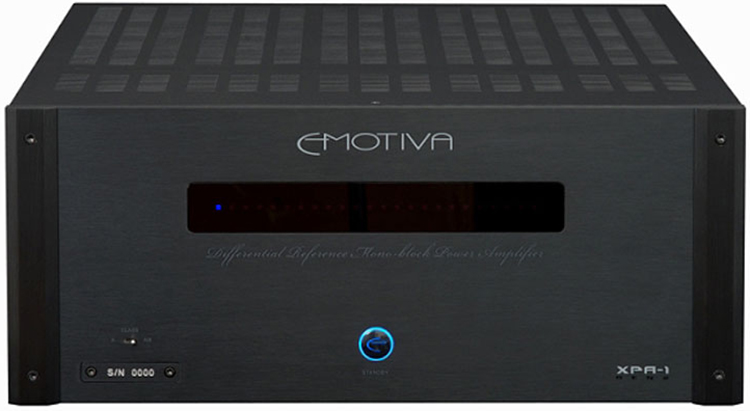
A number of comparably priced preamplifiers are available, with or without tubes. In the $3000-and-under range, credible contenders would include the Rogue Audio Perseus, Odyssey Audio Tempest SLB, Audio by Van Alstine FET valve CF, PrimaLuna Dialogue 3, Parasound HALO P7, Vincent Audio SA-T7 and an infinite variety of used preamplifiers. Although I’ve heard many of these, I haven’t spent enough time with them to provide an accurate comparison.
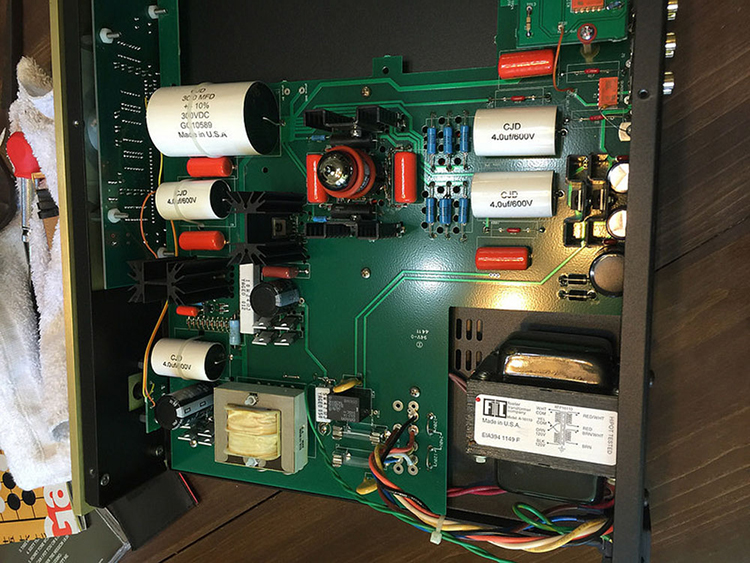
Suffice it to say that the CJ ET3 is quirky enough with its treble emphasis and dynamic midrange that it will probably resist direct comparisons with any competitor. You’ll either love the CJ sound immediately, or you won’t. The ET3 is, more than any other preamp I’ve heard, one that you should listen to carefully before you buy.
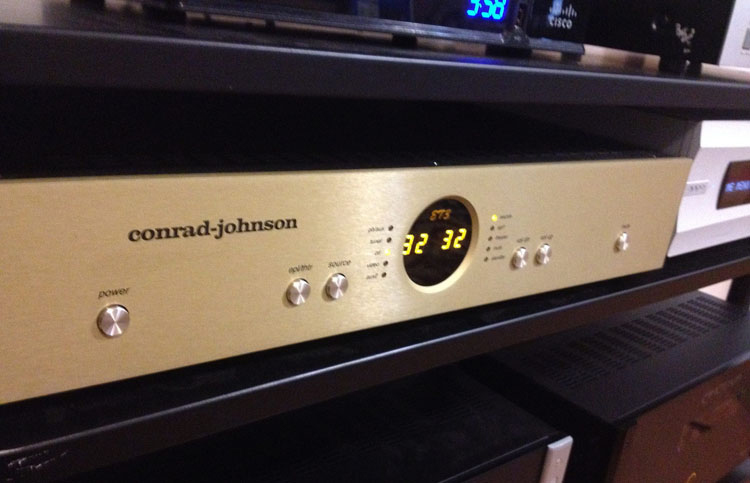
I Can’t Say That the conrad-johnson ET3 Is a Neutral Component. Its Unique Sound Signature is Audible on Every Recording.
- Exceptional dynamics
- Airy, shimmering treble
- Affinity for rock music
- Strong, punchy bass
- A bit less of that airy, shimmering treble
- Smoother frequency response, particularly in the midrange
- Dual preamplifier outputs
I can’t say that the ET3 is a neutral component. Its unique sound signature is audible on every recording. So if you’re one for whom fidelity to the original recording is paramount, you’ll not likely find this preamp to your taste.
I’m a bit surprised at the ET3. The special edition version of this preamp is on most everyone’s recommended-component list. But given the treble emphasis and midrange dynamic exaggerations that the base ET3 model exhibits, I wouldn’t necessarily consider this model a high-end contender. Since I haven’t heard the SE version, it may be significantly more neutral than the base model.
This is not to say that the preamp doesn’t have its charm – only that it isn’t sufficiently neutral to have a long-term place in my system.
If, however, you are looking for a high-resolution, fun-sounding take on music, and rock music in particular, then the ET3 provides it in spades. You’ll be listening more loudly to all your music just because it just sounds so good.
– Glenn Young & Garuka de Silva


